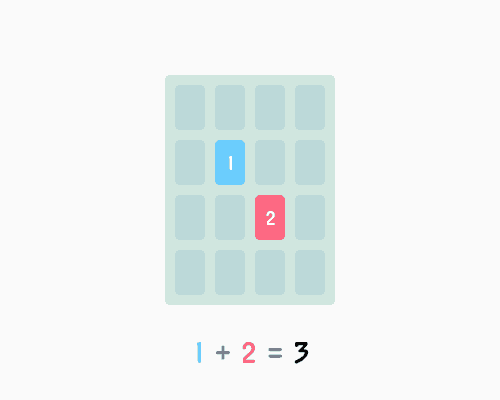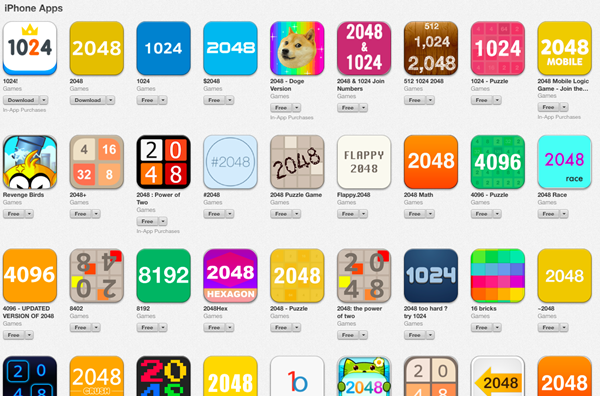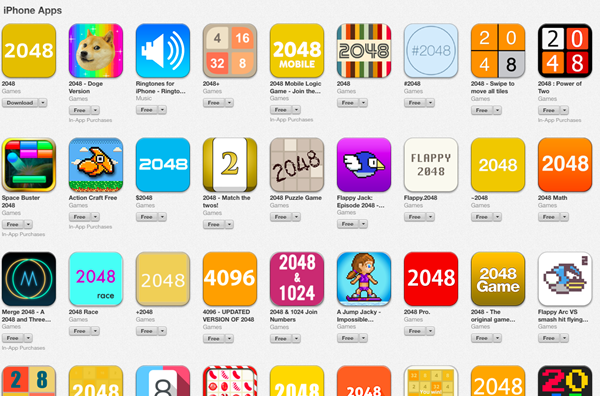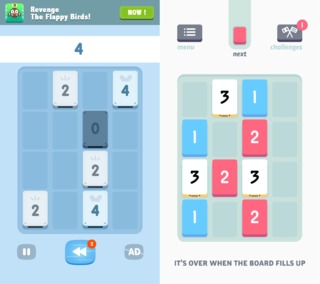Video games do not exist in a vacuum. Part of the medium’s magic comes from developers taking cues from one another, leveraging each other’s breakthroughs to develop their own. The reliance on borrowing is both a blessing and a curse, and these days, the ethics in-between are very, very blurry.

You might have played Threes, the card stacking number game, except you know it as 2048. There’s a chance you know it as 1024. There’s a chance you know it as the countless other clones of Threes. 2048 and 1024 are their own riffs on the concept of Threes, though neither could exist without Threes.
Clone is a curious word, especially in the context of video games. What constitutes a clone, and what's the difference between stealing and inspiration? The question becomes tougher as the games become smaller, and the democratization of development tools makes it easier and easier to make games.
If you search for 1024 in the App Store, here’s what comes up:

You'll find a similar situation on the Google Play store. Searches on both stores for 2048 are just as prolific:

In short, the popularity of Threes proved attractive. Clones don’t arrive unless there’s something worthy of cloning. Threes, like Flappy Bird, is worth cloning. There's money in this banana stand.
Our journey into the world of Threes clones begins at ground zero. 1024, which first appeared on the App Store on February 27, was created by 28-year-old designer Yeung Jason in Beijing, China. Threes first appeared on the App Store on January 22.

Jason told me he’s a big fan of thatgamecompany’s Journey, and Threes co-creator Asher Vollmer once worked at that studio. That’s how he found Threes, and became entranced by it. 1024, he told me, was created for his fiancée, and he only later decided to publish it to the App Store and Google Play.
He does not consider 1024 a clone.
“No,” he said over email. “Never. As I said, I made it for fun and for my fiancée.
Jason explained that the reason 1024 not only borrows the design of Threes but the game's visuals, as well, is because he wanted to make the game “fast.” His work on 1024 led him to create Monster Grow!, a conceptually similar game for “kids and girls” with a new look and without any of the math. The numbers turned some players off.
“Good artists copy, great artists steal,” he said. “Clone=Copy. Inspiration=Steal. Any design cannot be completely free of plagiarism. But the difference between clone and inspiration is how much thought was put into it. It does not matter what it looks like.”
As of this week, Jason said he’s made around $1,000 off 1024.
The release of 1024 is where the worm began to turn. Two clones of 1024, each called 2048, sprung up. One was created by a French designer by the pseudonym of Samig. This version of 1024 lacks any charm, and the coder was aggressively hostile about his game’s origins in a FAQ on the website:
Q: You're just a shitty ripoff
A: That's not a question. But yes, I did copy the concept from other guys. However they had it on Android and iOS only and my mobile isn't compatible. You know what is compatible with almost anything ? A web page. That's compatible with PCs, tablets, smartphones, consoles... hell even some fridges. I don't put make the visitors pay anything to play the game, that would be morally bankrupt.
The version of 2048 most are familiar with, however, is from 19-year-old Italian designer Gabriele Cirulli. Though it doesn’t have the colorful characters and voices from Threes, the animation channels the playfulness that helps make Threes such a delight to mess around with.
Cirulli’s version of 2048 did not launch with a credit to Threes for a good reason: he hadn’t played it. The hat tip to Threes came later, once Cirulli’s 2048 became a viral sensation. Though his version of 2048 has taken some of the attention away from Threes, he’s not trying to hide the reason 2048 exists in the first place.
“Essentially, it is a clone of Threes, although an indirect one,” he said over email. “I was inspired by 1024, which is an actual clone of the game. Due to that, it probably wouldn’t exist without Threes. Personally, I only use the word clone when something is the exact same, both visually and in terms of gameplay, to the allegedly cloned game. Personally, I believe spin-off, or 'inspired by' is a more appropriate term for the other cases.”
When Cirulli launched 2048, he actually sent an email to Jason, the Chinese designer of 1024.
“I built this as a fun weekend project, with no intention to profit off it,” wrote Cirulli in an email exchange that I confirmed with both designers. “I credited your original game in the footer as the source of my inspiration. […] I wanted to be proactive in email about his hoping that this wouldn’t give rise to any problems. I’m not planning to profit over this game concept either now or in the future.”
The email is proof of Cirulli's naivety about what he was actually cloning. This is the slippery slope, and reflects how the Internet both connects us and disconnects us at the same time. Threes is both present and not present.

Cirulli does not have ads on his website, but he does have an option for fans to submit donations. Though he hasn’t disclosed how much he’s made from people’s charity, he told me he's “happy” with them so far.
The young designer is aware that 2048 has impacted Threes, and doesn’t appear he takes that notion lightly.
“I can understand the frustration of the creators of Threes, though, and I believe it’s motivated,” he said. “ […] The amount of effort they put into Threes is very appreciable, and I’m sorry that I accidentally damaged it in part with 2048."

If Cirulli couldn’t have anticipated how far 2048 would spread, he likely didn’t anticipate what would happen as a result of making 2048’s code open source on GitHub, either. Making the game open source meant anyone could take the code and make their own variations on 2048. Some of them, like Doge2048, are hilarious, and very much in the spirit of the Internet’s collaborative nature.
Right now, 2048 is at the top of the “free” spot in the App Store. It hasn’t budged for well over a week, and it only seems to be accelerating in popularity. Cirulli did not make this version, which not only does not mention Threes or Cirulli’s original work. And this version has a very key difference: ads.
Who made this version of the game? Based on my reporting, it’s French designer Antoine Morcos.
This mobile version of 2048 was published by a company called Ketchapp, whose website has zero information about the people behind it. An email to the address listed went unanswered. I know about Morcos because I looked up the domain for ketchappstudio.com, and found him talking about other Ketchapp games:

His Twitter and Facebook feeds do not make mention of 2048, though the company is credited with publishing the game on the App Store. On Google Play, it's listed under Presselite, another mobile company Morcos is associated with. Morcos did not return any of my repeated attempts to discuss his business.
“I think it’s up to the people who are doing it to judge whether they’re doing the right thing,” said Cirulli.
Here are the other games Ketchapp has been responsible for in the last few months. Notice a trend?

Flappy Fish - Bird Flyer, Bird in the Dark - Flappy Flyer, Hoverbird Rider, Skater Monkey - No Flappy No Bird, Kitty Jetpack, and Grabby Bird - Flappy Bird Flyer are all shameless grabs at Flappy Bird's massive success. None of them appear to have really taken off, which cannot be said about the chart-topping 2048.
Ketchapp's business model, at least in games, seems to largely be about finding existing designs and looking for a way to ride the wave. One could argue 1024 and 2048 were creative riffs on Threes. One cannot make the same claim for Ketchapp's published version of 2048, which does not acknowledge Threes.
In 2048, Morcos found a goldmine. People love free, 2048 is a beloved riff on Threes, Threes isn’t free, and mobile-ready code was available for free online. The money was gift-wrapped for someone like Morcos.
There's nothing illegal about what Morcos pulled off, but that doesn't mean it sits well with everyone.
“That’s the incarnation of unethical behavior,” said Threes co-creator Greg Wolhwend. “That’s the culmination of it all right there in this long chain of clone of clone of clone of clone of clone blah blah blah. That’s the end thing. I do think if it wasn’t him, it would have been someone else. I’m betting that he rests on that at night when he goes to sleep. ‘It had to be somebody, it might as well be me.’’
Wohlwend has made his peace with most of this, including the web version of 2048. But not the app.

The designer doesn’t try to hide his obsession with reading what people think about the game. Google Alerts send him updates to articles written about Threes, and he will often spend hours browsing Twitter looking for idle conversations about his game. That means he’s constantly looking at 2048, too.
“I still sort of check the App Store top charts,” he said, “and it’s still number one, ‘’Oh, maybe it’ll go down a little bit!’ [laughs] It’s like checking your ex-girlfriend’s Facebook or something. You just shouldn’t do that. It still stings.”
As half of the team behind Threes, Wohlwend has reason to be frustrated. Though the clones of Threes vindicates the design, it not only means money and attention diverted elsewhere, it means others ran off with the game that took more than a year to create.
In response to the clones, Wohlwend and co. published a novel-length blog that outlined the lengthy creative process behind Threes, and how the seemingly simple game almost never came to be.
“We were thinking about so many different ways to tackle it,” he said. “‘Should we just throw a free version out there? We should try to compete! Maybe we should try to open source and put it on the web.’ It’s not like we’re not still thinking about those things because…how can you not? We felt like this was our answer, and it was the right answer.”
The nature of what defines a clone is complicated, and Wohlwend has given it substantial thought as this arc in the Threes story has played out. We talked about how when DOOM was originally released, games that would now be called first-person-shooters were commonly referred to as DOOM clones.
“When people see something new and they don’t know what else to call it, they call it that kind of clone,” he said. “With Threes, this is why it is complicated. In development communities especially, it’s not exactly a clone. It’s not the exact game system, but it is heavily borrowing and heavily derivative of what we’ve done.”
“I think Threes came out and people didn’t really know [how to classify it]” he continued. “It’s the beginnings of what I think are a bit of a genre thing, even though it’s very hard to call it a genre. Threes still does borrow from plenty of games, too. That’s how game development works, and that’s another complex thing.”
"Threes still does borrow from plenty of games, too. That’s how game development works."
Some prefer 2048 and 1024 to Threes, partially because of the easier learning curves. That’s fair, but a huge part of the viral success came from both being free.
Charging money for Threes was, in some way, a design choice. The price point for Threes might change in the future. Free was considered during the game's development. At one point, it could have been free with in-app purchases, such as the ability to “undo” moves on the board.
“That was a terrifying endeavor,” he said.
Ads were considered, but few games reach the popularity to make the ads a viable business model. Flappy Bird is an aberration, with a success that's impossible to replicate. A closer examination of in-app purchasing prompted them to back off the idea.
“To do that well,” he said. “It takes a village. [laughs] The worst kind of village, a village you don’t want to be in or visit. You need an economist, you need a psychologist, and you need all this testing and analytics people. It feels gross, and it’s nothing I ever want to be a part of.”
Threes is not the first time Wohlwend has experienced the consequences of cloning. He worked on the updated version of Ridiculous Fishing, a game that was cloned before it was released. (Read about that here.) But Wohlwend learned an important lesson on Ridiculous Fishing that informed the price of Threes.
“People are just so thirsty and so starving for a game that’s just honest,” he said. “Just get it, and you don’t have to deal with any of these psychological yearnings.”
All that said, Threes has soured Wohlwend on the prospect of making more mobile games. He hasn’t ruled it out, though, and he’s working on finishing a completely separate mobile project--another puzzle game--that will be released in the next few months. But the experience has given him pause on future designs.
“I’m trying to go towards the uncloneable games,” he laughed.
(Full disclosure: On some afternoons, I work in the same office as Wohlwend.)